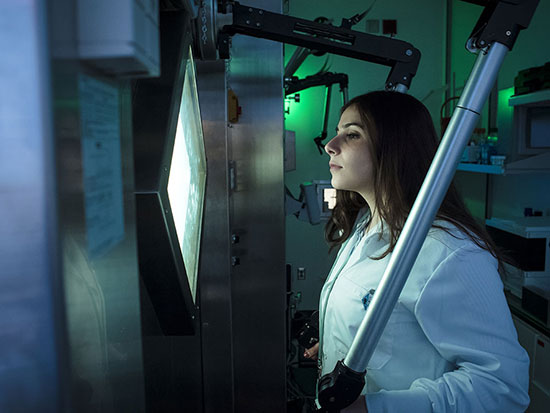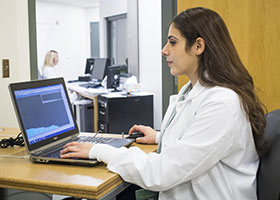Media contact: Beena Thannickal
 Many aspiring scientists wonder how they’ll find the right lab to launch their research career. Retta El-Sayed was pulled right in by a giant magnet.
Many aspiring scientists wonder how they’ll find the right lab to launch their research career. Retta El-Sayed was pulled right in by a giant magnet.
For the past two years, El-Sayed, a senior majoring in biomedical engineering, has worked in the UAB Cyclotron Facility, studying exotic radioactive isotopes with the facility’s team of radiochemists. [Learn more about the high-speed world of cyclotron research in this Mix feature.]
It all began when El-Sayed was a sophomore. A friend in medical school invited her along on a tour of UAB’s cyclotron, a 60-ton behemoth used to create the radioactive particles needed for PET imaging. “I wasn’t expecting anything,” she says, but during the tour she got excited about the cyclotron and its potential for creating new types of imaging for cancer research: “I think it’s one of the coolest pieces of research equipment at UAB.”
| “I think it’s one of the coolest pieces of research equipment at UAB.” |
She emailed Suzanne Lapi, Ph.D., director of the cyclotron facility, to ask about volunteering in Lapi’s lab. “She ended up hiring me,” El-Sayed says. “It was really cool.” El-Sayed has worked with doctoral student Stacy Queern to produce Zirconium–89, an isotope that can be used to study the effects of the drug trastuzumab on breast tumors. She helps Tolulope Aweda, Ph.D., label antibodies with radioactive isotopes such as Copper–64 and Gallium–68, and assists Adrianna Massicano, Ph.D., in electroplating copper coins with chromium, a crucial step in producing manganese–52.
 |
| Retta El-Sayed |
|
Major: Biomedical Engineering Hometown: Damascus, Syria (Palestinian Syrian) Career Interests: Plans to pursue a Ph.D. and a career in bioimaging. Class: Senior |
“I have learned how to be a scientist — how to search and find a solution to a problem,” El-Sayed says. “All of Dr. Lapi’s team members have been my mentors throughout my time at the lab, and they have been teaching me different things every day.”
The work with manganese–52 is particularly exciting, says El-Sayed. Unlike most currently used PET imaging agents, which have a useful lifespan of only a few hours, manganese–52 has a five-day half-life. “The longer half-life lets us conduct imaging studies over much longer time periods” using a single dose of manganese, El-Sayed says.
But before that can happen, researchers such as Lapi and her team must establish a safe, efficient production process. El-Sayed’s work has already been part of one publication, “The Production of Zr–89 using sputtered yttrium coin targets,” in the Nuclear Medicine and Biology Journal.
El-Sayed’s presentation on her manganese–52 work at the UAB 2017 Fall EXPO earned first place in the physical and applied science category. In March, El-Sayed will present her research at the national American Chemistry Society conference in New Orleans. “This is a very important conference in this field and I am thrilled for this opportunity,” she says. “This work has great potential and we are planning to publish it, in a peer-reviewed journal, this year.”